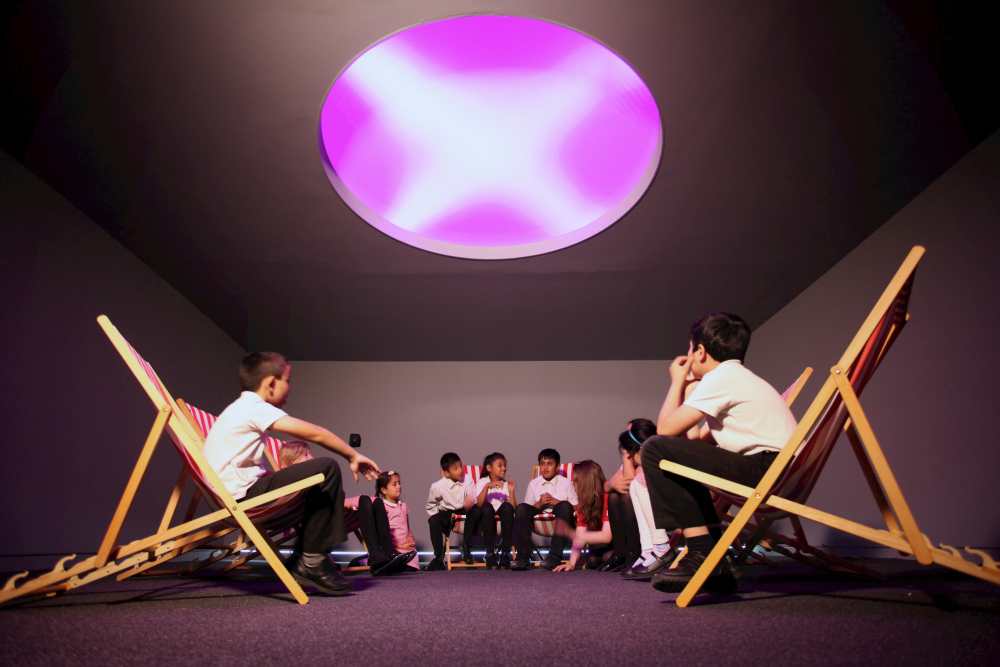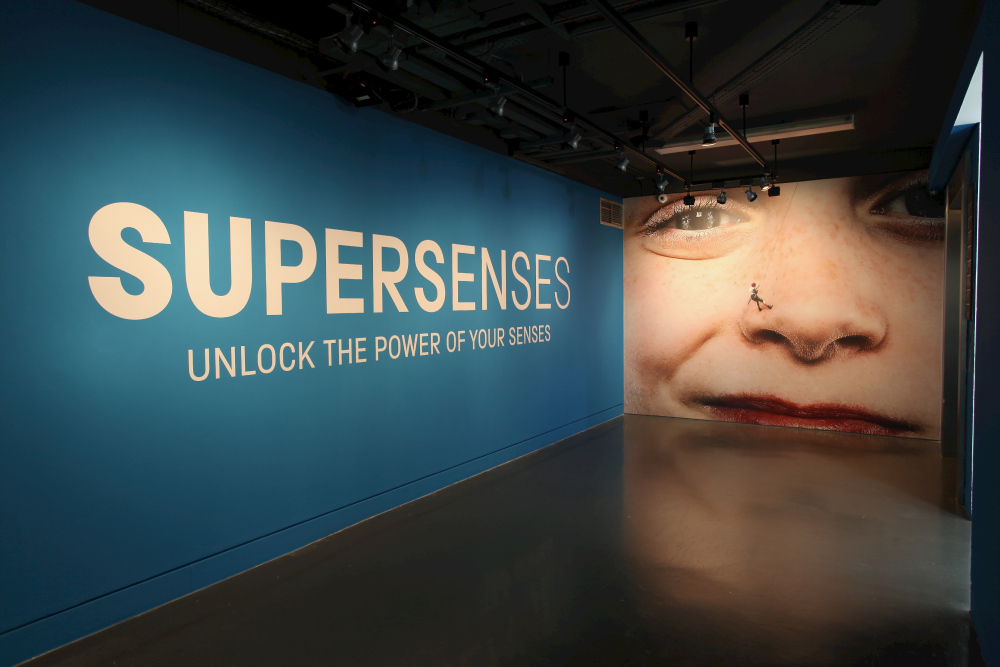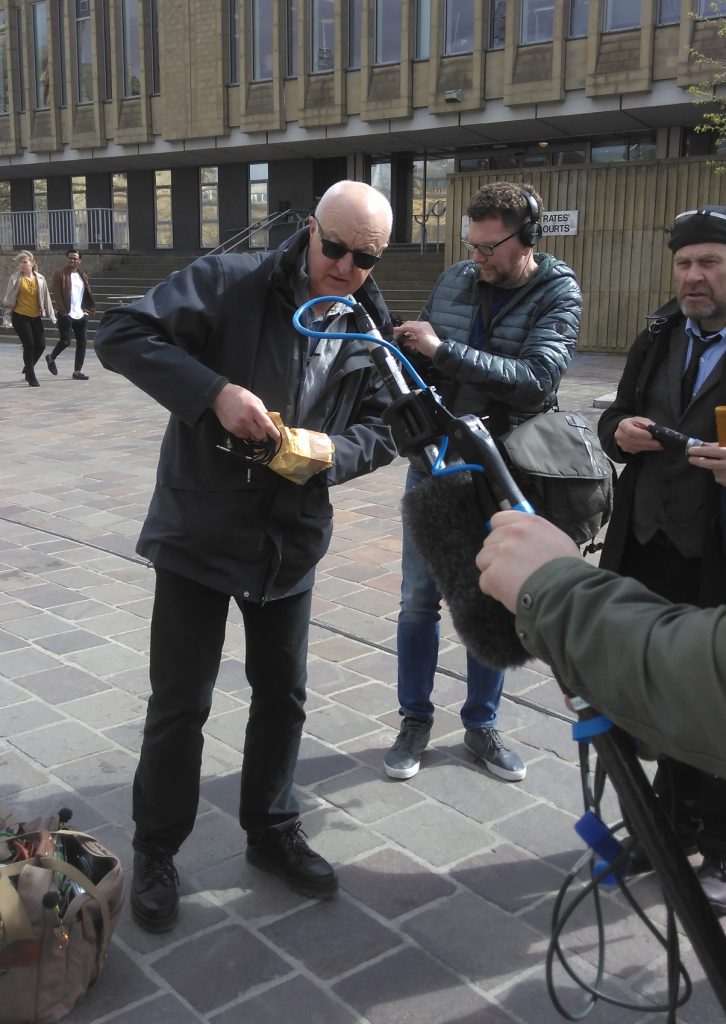
Journey Through the Mirror Pool is a nine-minute multichannel sound installation that takes audiences on a sonic descent: from Bradford’s town hall clock, through the surface of the Mirror Pool, to the mechanical underbelly of drones and industrial pumps. Created with Alan Dunn and Danny Saul, the installation is part of Supersenses, open at the National Science and Media Museum until 8 October 2017.
Recordings
Work for creating Journey Through the Mirror Pool began with a two-day recording session led by sound recordist Chris Watson, along with Alan Dunn and students from Leeds Beckett University. Sounds were recorded around Bradford using contact mics, hydrophones, bat detectors, electromagnetic frequency detectors and other recording equipment. The aim was to unveil hidden sounds that are undetectable to the everyday ear without specialist listening or recording equipment.

Concept
The Mirror Pool is a public leisure destination in the centre of Bradford where families go together to play and socialise. Iit’s the largest urban water feature in the UK, and is a key part of the urban regeneration and focal point for the town. Over the course of a day the public square fills with water to form the pool, which is powered by a large pumping station and network underneath.
We researched the town’s history of working class families visiting Morecambe—or ‘Bradford by the Sea’, as it became known—on holiday. The piece is presented as a dystopian industrial beach where, after the decline of the town’s industry, the machines that once powered the economy now work to provide leisure for the people.
For a collective, focused listening experience, audiences sit on deckchairs in a specially built sound space. The aim is to encourage listeners to hear unfamiliar sounds and consider sound—and how we listen—in a different way. The listening experience was designed as a ‘coming together’ and has something of a ritualistic feel, enhanced by the lighting and cocooned environment.
Sound design and production
Over 170 individual pieces of audio were recorded on the days with Chris Watson. Following a playback day at Leeds Beckett University, where we discussed the recordings made, we took these back to the studio to begin the process of listening to the content, grouping, and starting to sketch out a sonic narrative for the piece. These were our initial groupings of audio:
- Dawn chorus (birds, Bradford town centre)
- Ambient mirror pool recordings, including people/voices (above surface)
- Town clock chimes
- Submergence under water (hydrophone recordings—going under water)
- Descent underground (ambient—darker room lighting)
- Drones (machines/textures)
- Rhythmic sounds (mechanical sounds)
- Electromagnetic buzzing (power station)

To compose the piece, we worked with a combination of Ableton and Reaper DAWs (digital audio workstations) with associated plug-ins and effects. The sonic textures of the piece are quite distinct: the opening above the surface, with its very naturalistic recordings; the whirling descent, submerging in the water; and the more heavy industrial rhythms and textures.
We spent a good few weeks listening to mechanical drones and industrial rhythms to achieve the ‘beneath the surface’ section, where we equalized over 40 individual tiny audio samples of drones, textures and timbres to spatialise and randomised for a particular flutter section. We also worked with electromagnetic recordings, using amplitude modulation and quad panning to achieve movement and dynamism within the piece.

It was the first time we had worked in multi-channel. Pro Audio provided us with a serious surround-sound set up in our Noise studio to compose. We invited Danny Saul to collaborate with us and help us realise our production in multi-channel, using his expertise in sound design to create the ‘descent’ segment of the piece.
We wanted the audience to experience movement across space, a feeling of submergence, and of being transported or ‘within’ the sounds through this listening experience.
Lighting
We were also thrilled to work with Sam Meech who designed the lighting for the installation, producing a visual narrative that helped to make Journey Through the Mirror Pool a theatrical experience. The lighting was crucial to shape the audience’s suspension of reality. Scenes unfold through evolving colour washes and accents, producing a mesmeric effect.
Thanks to John O’Shea, Kate Davies and the team at the National Science and Media Museum, Danny Saul, Sam Meech, Alan Dunn and Leeds Beckett students, and Steve Cummings.





